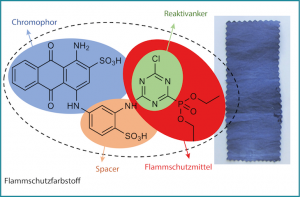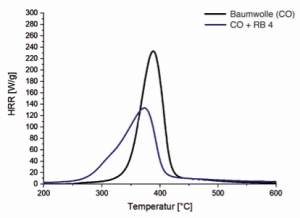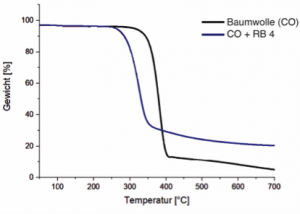Flame retardant dyes – Novel approach of a multifunctional finish
Dyeing is an important finishing step for many textiles, which requires large amounts of water and energy. Combining two finishes into one step allows these resources to be saved, reducing the ecological fingerprint of such a textile. German SMEs thus have the opportunity to both save costs and offer an environmentally friendly product.
Many dyes are optimised to be permanently bound to textiles from water. At the same time, due to their chemical composition, they offer the possibility of combining them with flame retardants. Many dyes already contain nitrogen and have functional groups that can be easily functionalised with phosphorus. In the case of reactive dyes, the reactive anchor cyanuric chloride is perfect for binding flame-retardant phosphorus.

Figure 1: A flame retardant dye synthesised at DTNW based on Reactive Blue 4 (RB 4), with the cyanuric chloride group serving as an anchor and flame retardant. The textile was dyed with the dye.
Textiles were successfully dyed with the synthesised dye in Fig. 1. The decomposition of the dyed textiles was investigated by micro combustion calorimetry (MCC) and thermogravimetry (TGA) (see Fig. 2). In both the MCC and TGA measurements, the typical behaviour of a flame retardant can be observed. In the MCC measurement, the rate of heat release is clearly reduced, and in the TGA measurement, the earlier onset of decomposition of the cotton, which speaks for the ash-forming effect of the flame retardant.

MCC

TGA
Figure 2: MCC and TGA measurements of RB 4 on cotton. The MCC measurements show a significantly lower heat release rate (HRR) and the TGA the earlier decomposition of the cotton with a significantly higher ash content.
The focus of this project is on the development of dyes that also function as flame retardants. In terms of market potential, cotton (CO) and PET are the two most important fibre materials. Therefore, corresponding reactive and disperse dyes are to be developed, which have a comparable washing resistance as well as light and rub fastness as the original compound. At the same time, CO or CO/PET textiles should pass the flame retardancy test for work clothing or PET fabrics the test according to the building materials standard solely through the dyeing process.
Forschungsvorhaben:
Kennwort: Flammschutz Farbstoffe
Förderkennzeichen: 22599 N
Laufzeit: 1.10.2022-30.09.2024
Projektpartner: DTNW
Weitere Informationen zum Download:

